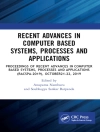This comprehensive and self-contained, one-stop source discusses phase-field methodology in a fundamental way, explaining advanced numerical techniques for solving phase-field and related continuum-field models. It also presents numerical techniques used to simulate various phenomena in a detailed, step-by-step way, such that readers can carry out their own code developments.
Features many examples of how the methods explained can be used in materials science and engineering applications.
สารบัญ
PART I: Phase Transformation in Materials Science
1. Introduction to Phase transformations and microstructure formation in materials science
2. An example: Solidification of pure materials
3. Phase Transformations and Phenomenology of Landau
4. Phase field model for solidification in pure materials
5. Phase Transformations in binary alloys
6. Phase-field models of phase transformations in binary alloys
7. Applications to microstructure growth in binary alloys
8. Connection between phase-field and sharp-interface parameters
PART II: Elastic and Plastic Effects in Phase Transformations
1. Review of Mechanics of Materials
2. Overview of Modeling and Simulation Techniques in Mechanics
3. Phase-field Models
4. Applications: Effects of Elastic Stress on Thin Film Growth and Phase Transformations
PART III: Modeling Atomic Scale Systems using the Phase-Field Method
1. Phase field Modeling of Periodic Systems
2. Modeling Crystals with Phase Fields
3. Applications
PART IV: Numerical Solution Methods for simulating Phase-Field Models
1. Introduction to Numerical Methods for PDEs – Space Discretization
2. Iterative Methods for sparse Linear Systems
3. Numerical Methods for PDEs – Time Marching Schemes
4. Discretization of the Diffusion Equation
5. Discretization of Advection Diffusion Equations
6. Introduction to the Message Passing Interface (MPI)
7. Solved MPI Examples
เกี่ยวกับผู้แต่ง
Nikolas Provatas is an Associate Professor of Materials Science and Engineering and a member of the Brockhouse Institute for Materials Research at Mc Master University. He received his Ph.D. in Physics from Mc Gill University. His research in solidification modeling, microstructure formation, reaction-diffusion kinetics and paper physics has been published in numerous high impact scientific journals. He has worked at several prestigious institutions including the University of Illinois at Urbana-Champaign, the University of Helsinki and the Pulp and Paper Research Institute of Canada. His research has also included close collaboration with industry to develop new modeling paradigms for predictive modeling of microstructure-property relationships in materials manufacturing.
Ken Elder is an Associate Professor of Physics at Oakland University. Having obtained his Ph.D. from the University of Toronto, he then worked at Mc Gill University, Lehigh University and the University of Illinois at Urbana-Champaign before taking up his present appointment at Oakland University. Dr. Elder has published over 50 scientific articles; his research in condensed matter physics is funded by the National Science Foundation.












